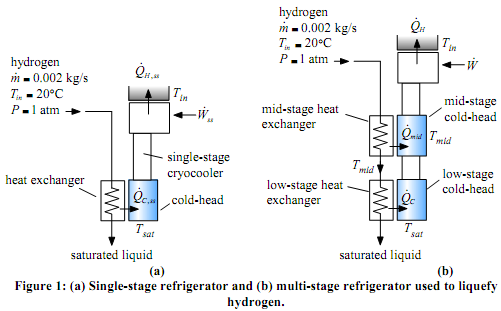Please use EES to solve this problem.
One method for storing hydrogen involves cooling it so that it liquefies. Figure 1(a) illustrates a single-stage refrigerator that is used for this purpose. A refrigerator that operates at very low temperature is referred to as a cryocooler.

A stream of gaseous hydrogen at m. = 0.002 kg/s at Tin = 20ºC and P = 1 atm is fed to the device. The gaseous hydrogen is liquefied by flowing through a heat exchanger that interfaces with the cold-head of the cryocooler. The cold head is held at the saturation temperature of the hydrogen, Tsat, and hydrogen exits the heat exchanger as saturated liquid. Assume that the cryocooler operates at steady state, is internally reversible, and rejects heat at temperature Tin. Assume that there is no pressure loss associated with the flow of hydrogen.
a.) Determine the rate of heat transfer to the cold head at Tsat, Q.C,ss.
b.) Determine the rate at which heat is rejected from the cryocooler to Tin, .QH,ss
.
c.) Determine the rate of power consumed by the cryocooler, .Wss. What is the coefficient of performance of the cryocooler?
Figure 1(b) illustrates an alternative, two-stage cryocooler used for liquefaction. A two-stage cryocooler can provide refrigeration at two separate temperatures. The hydrogen is cooled to an intermediate temperature, Tmid = 100 K, by flowing through the mid-stage heat exchanger that interfaces with the mid-stage cold head of the cryocooler. The mid-stage cold head is maintained at Tmid. The hydrogen
leaving the mid-stage heat exchanger is cooled by flowing through the low-stage heat exchanger that interfaces with the low-stage cold-head of the cryocooler.
The low-stage cold head is held at the saturation temperature of the hydrogen, Tsat, and hydrogen exits the low-stage heat exchanger as saturated liquid. Assume that the two-stage cryocooler operates at steady state, is internally reversible, and rejects heat at temperature Tin. Assume that there is no pressure loss associated with the flow of hydrogen.
d.) Determine the rate of heat transfer to the mid-stage cold head at Tmid, .Qmid.
e.) Determine the rate of heat transfer to the low-stage cold head at Tsat, .QC .
f.) Determine the rate at which heat is rejected from the two-stage cryocooler to Tin, .QH.
g.) Determine the rate of power consumed by the two-stage cryocooler, .W .
h.) Plot the rate of power consumed by the two-stage cryocooler, .W , as a function of the mid-stage temperature, Tmid.
i.) Your plot from (h) should show that there is an optimal mid-stage temperature. Explain carefully and clearly why this optimal value exists.